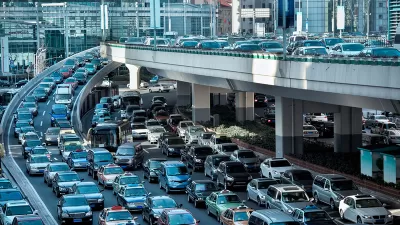Those who thought peak VMT was in the rear view mirror will be disappointed in new data from the Federal Highway Administration.
"Vehicle miles traveled (VMT) reached a record 987.8 billion for the first four months of the year," writes the American Association of State Highway Transportation Officials Journal editor. "The previous record for January through April of any year was 965.5 billion VMT, set in 2007."
With the record one-month estimate for April reaching nearly 270 billion miles, VMT will have increased "14 months in a row [since March 2014], as vehicles put more traffic demand on the nation's road and bridge network," according to AASHTO. "The FHWA said that volume growth underscores 'the need for greater investment in transportation infrastructure.'"
VMT data is not population-adjusted
As Planetizen blogger Steven Polzin, of the Center for Urban Transportation Research at the University of South Florida acknowledged in his April post about 2014 VMT data, it's important to take into account increased population. "With 17 million more people, VMT per capita remains below peak levels."
That conclusion was affirmed earlier in September 2014 and May 2014 posts showing that VMT was at "another new post-Financial Crisis low...if we factor in population growth [and] the civilian population-adjusted data (age 16-and-over)."
Where traffic is on the rise, and where it isn't
According to FHWA's press release, "At 60.9 billion unadjusted VMT, traffic in the West – 13 states including Alaska and Hawaii – was the nation's most-traveled region for the second consecutive month, and the 19th month in a row of VMT growth. The Northeast, a region of nine states stretching from Maine to New Jersey, showed the smallest growth – rising only 2.4 percent, or 37 billion VMT, compared to the same month a year earlier." The total April increase was 3.7 percent compared to April 2014.
"The complete VMT data is available in the FHWA's "Traffic Volume Trends" reports, based on information collected from more than 4,800 continuous count stations nationwide," adds AASHTO.
FULL STORY: FHWA Says Driving Volumes Set Records for April, First Four Months of Any Year

Study: Maui’s Plan to Convert Vacation Rentals to Long-Term Housing Could Cause Nearly $1 Billion Economic Loss
The plan would reduce visitor accommodation by 25,% resulting in 1,900 jobs lost.

Alabama: Trump Terminates Settlements for Black Communities Harmed By Raw Sewage
Trump deemed the landmark civil rights agreement “illegal DEI and environmental justice policy.”

North Texas Transit Leaders Tout Benefits of TOD for Growing Region
At a summit focused on transit-oriented development, policymakers discussed how North Texas’ expanded light rail system can serve as a tool for economic growth.

Paris Bike Boom Leads to Steep Drop in Air Pollution
The French city’s air quality has improved dramatically in the past 20 years, coinciding with a growth in cycling.

Why Housing Costs More to Build in California Than in Texas
Hard costs like labor and materials combined with ‘soft’ costs such as permitting make building in the San Francisco Bay Area almost three times as costly as in Texas cities.

San Diego County Sees a Rise in Urban Coyotes
San Diego County experiences a rise in urban coyotes, as sightings become prevalent throughout its urban neighbourhoods and surrounding areas.
Urban Design for Planners 1: Software Tools
This six-course series explores essential urban design concepts using open source software and equips planners with the tools they need to participate fully in the urban design process.
Planning for Universal Design
Learn the tools for implementing Universal Design in planning regulations.
Smith Gee Studio
Alamo Area Metropolitan Planning Organization
City of Santa Clarita
Institute for Housing and Urban Development Studies (IHS)
City of Grandview
Harvard GSD Executive Education
Toledo-Lucas County Plan Commissions
Salt Lake City
NYU Wagner Graduate School of Public Service





























